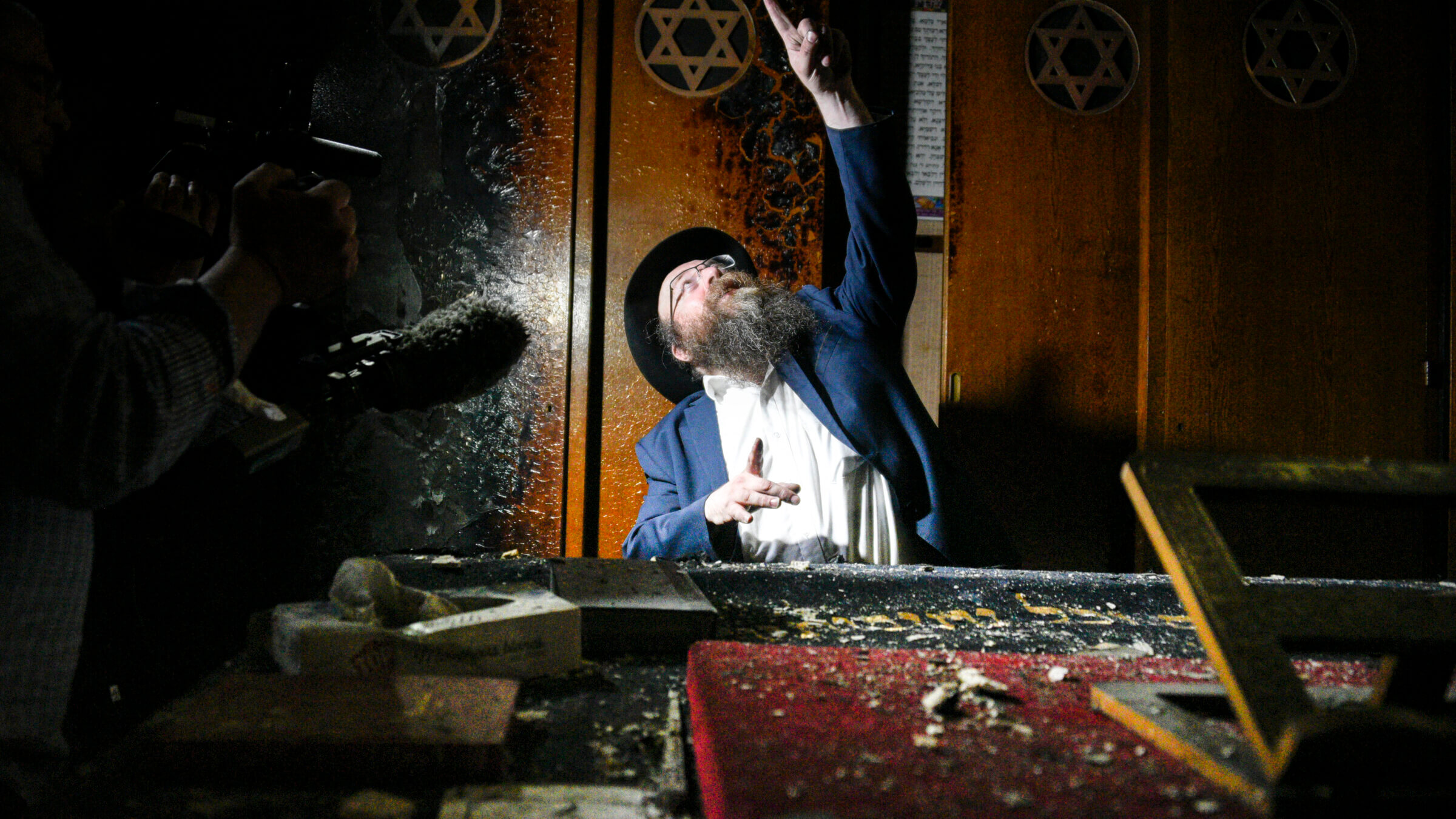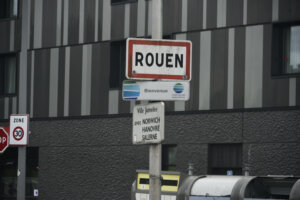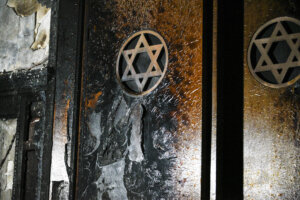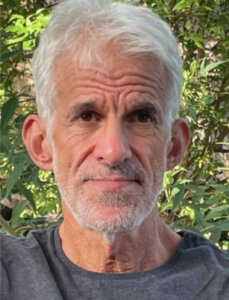France would like to believe that an antisemitic arson attack was an aberration — history says otherwise
A recent incident presents some eerie parallels to the First Crusade

The rabbi of Rouen, Chmouel Lubecki, shows the fire damage in Rouen’s main synagogue. Photo by Getty Images
Last week, the recent surge of antisemitic incidents in France caught fire — literally. On Friday morning, smoke began to belch from the windows of the synagogue in the northeastern city of Rouen. When police arrived at the scene, they saw a young man, armed with a knife, clambering out one of the windows. When he refused to drop the knife, and instead waved it threateningly, an officer shot and killed him.
According to government officials, the arsonist was an Algerian citizen who, denied a recent request for a residence visa, had been ordered to leave France. Though sought after by the police, the 24-year-old suspect managed to elude them long enough to carry out what Gérald Darmanin, the Interior Minister, described as “hostile intentions on our soil.” For the benefit of those in a coma for the past several decades, or at least since last October, Darmanin described those same intentions as “clearly” antisemitic.
Fortunately, the fire, though it torched part of the Bimah and interior, was extinguished before it reached the Torah scrolls, as well as the exterior walls of the synagogue. No less fortunately, the incident galvanized both the political class and civil organizations, joining in chorus of denunciations. In the company of Francis Kalifa, president of the Representative Council of French Jewish Institutions, and Élie Korchia, president of the Central Jewish Consistory of France, Darmanin visited the synagogue later that same day, praising the quick response of police and firefighters. That same evening, at a public seder on the Place de la République in Paris, the mayor, Anne Hidalgo, insisted that religious diversity and tolerance are part of the city’s DNA.

Unfortunately, Hidalgo’s grasp of history is no more reassuring than her flights of rhetoric. Religious intolerance has also long been part of France’s history. The Seine that runs through Hidalgo’s city was turned red with Protestant blood during the Saint Bartholomew’s massacre in the late 16th century; the Revocation of the Edict of Nantes — the document that sought and failed to impose tolerance between warring Christian sects — in the 17th century, turned Protestants into enemies of the state; and in the 18th century, Voltaire turned to write his Treatise on Tolerance following the torture and execution of the Protestant Jean Calas by Catholic leaders in Toulouse. His treatise proved no more successful than did the Nantes treaty.
Of course, the history of French Jewry reminds us that religious intolerance is not only intramural in France. As Samuel Lejoyeux, president of the Union of Jewish Students of France (UEJF) remarked, “the image of an incinerated synagogue belongs to history books.” History, and images of incineration, run deep in Rouen. For most Americans, perhaps, it stretches back no further than the Second World War. During what is known as “la semaine rouge” or “red week,” large swathes of the medieval city’s center were leveled by Allied bombers in the lead-up to the June landings. Whether the color of red refers to the fires that swept through the timbered building or the blood of thousands of civilians killed by British and American bombs is not clear.
What is clear, though, is that the images of incinerated buildings and mass death in Rouen stretch back not just several decades, but several centuries. In 1096, Rouen was one of the launching pads for the First Crusade. The official crusade, though, was preceded by the so-called Peoples Crusade, let by a charismatic cleric known as Peter the Hermit.
It turned out that the tens of thousands of peasants, and occasional knight, filling the ranks were neither terribly disciplined as soldiers nor discriminating when it came to infidels and heretics. The commoners cosplaying as crusaders were as eager to rid Europe of Jews as to rid the Holy Land of Muslims. Among the first to discover this was the Jewish community of Rouen, whose own presence in Normandy dated back to Roman antiquity.
According to the Benedictine chronicler Guibert of Nogent, the crusaders gathering in Rouen realized that “having crossed great distances [mostly from England] to attack the enemies of God in the East, we find the worst enemies of God, the Jews, are right under our nose.” In short order, the crusaders gathered the Jewish community in the synagogue and threatened to kill those who refused to convert to Christianity. Without making any distinction between age or sex, they slaughtered those who refused, destroyed the synagogue, and marched westward to join their companions in the Rhineland. Once they carried out several more Jewish massacres, most infamously in Worms, they continued across the Bosporus, where they were promptly routed by Turkish forces.
Shortly after the massacre, the survivors began the rebuilding the synagogue. Known as “La maison sublime” — a phrase inscribed on its walls — its ruins were accidentally discovered in 1976 when construction workers at the Palais de Justice stumbled across this subterranean treasure. Refurbished and reopened as an historical site — one that is a few blocks from the current synagogue, built in the mid-19th century — this sublime house has earned its moniker: it stands as the oldest site of Jewish worship in France.

Nearly a millennium separates us from the launching of the First Crusade, but it seems like yesterday. The parallels are striking. In the late 11th century, state institutions, religious as well as secular, were mostly appalled by the massacres and sought, to varying degrees, to protect their Jewish subjects. More than nine centuries later, French secular and religious leaders are, once again, voicing their outrage over acts of antisemitic hatred, with both Catholic and Muslim leaders rallying to the country’s Jewish community.
No less striking, the accusation of blood libel, which galvanized mobs of peasants to slaughter Jews and burn synagogues at the end of the 11th century, remains alive and well today with the many claims made by Islamic and far-left extremists that Israelis are “harvesting” the organs of dead Palestinian children for their own use. Or, for that matter, we see how the old conviction that Jews exercised great powers from dark places has morphed into the new conviction that Israel has made this darkness visible as an imperialist and supremacist nation.
But perhaps most striking, and certainly most tragic of all is that, in 2024, the image of an incinerated synagogue has yet to be relegated to the yellowing pages of history texts.
















